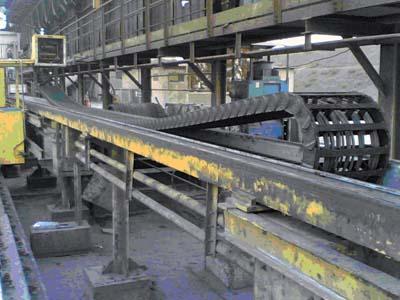
Cable carrier systems not only transport energy, data and media to various types of machines, but also greatly influence energy costs. To keep energy costs low, one important consideration is the amount of pull-push, or driving force, that is required at a given speed to move the cable carrier. Secondly, the stability and maximum weight for the cable carrier system is also important to ensure it consumes the least amount of energy possible. Energy Chain cable carriers, combined with Chainflex continuous-flex cables from igus, can reduce the required drive power, energy consumption and costs for environmentally conscious applications.
Recent tests and sample calculations performed at igus' test laboratory prove energy consumption can be drastically reduced by using the right cable carrier material with a sophisticated design, especially in long-distance, high-load applications. If Rol-E-Chain, a specially designed cable carrier with built-in wheels that rolls insteads of glides to facilitate travel over long distances, is used, the friction factor is drastically reduced from 0.3 to less than 0.1. This correlates to a 37 percent reduction in drive power with Rol E-Chain when compared to a traditional gliding application, as well as a significant decrease in overall costs.
Metal cable carriers are being replaced more and more by plastic Energy Chains because they are lightweight, require no lubrication and can withstand even the toughest applications. One example is a 1,804 foot Rol E-Chain system being used in a taconite mine in Minnesota. Another is the longest known Energy Chain application in the world: a 2,018 foot cable carrier system in a lignite-fired power plant in the Czech Republic.
A third application in which Energy Chains replaced metal cable carriers is at a steelworks company in Iran. The steel cable carrier failed because of a combination of dust, lubricants and oils. The cables were also damaged by the sharp edges of the metal carrier and UV radiation from the sun. In addition to reducing friction, Rol E-Chains are energy efficient thanks to their dimensions and weight.
A comparative test in the igus test laboratory proved that 17 percent of the drive power required can be saved by using an Energy Chain with smaller dimensions, yet which can still handle heavy loads. The test used an E4 Energy Chain, which is suitable for long travels and unsupported, side-mounted applications. Cable sheathing and insulating materials Chainflex continuous-flex cables can also reduce energy consumption. igus tests show that using high-performance sheathing and insulating materials, depending on the combination of cross sections and number of cables used, can provide between a five and 30 percent reduction in energy.
In addition, if the sheathing mixtures are optimal for the application, abrasion will be reduced. High-quality sheathing materials can be extruded with an extremely thin wall, which saves up to 18 percent in weight compared to conventional cables. These two factors can reduce the drive power required. High-grade insulating materials can achieve higher currents with the same electric cross-sections, which means the cross-sections can often be reduced without compromising the electrical performance. This enables weight reductions of up to 30 percent.






